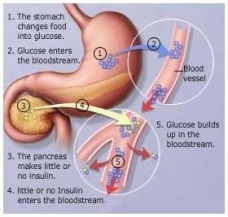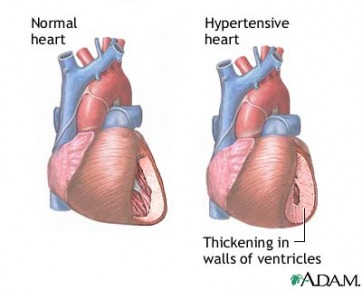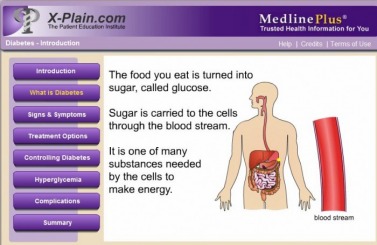Coronary Heart Disease (CHD)

The heart, like every other organ in the human body, needs a constant blood supply in order to receive nutrients and get rid of wastes produced by the cells that make it up. For the heart, this blood is supplied by the coronary blood vessels that branch all over the surface of the heart.
In CHD the inside surfaces of coronary vessels become thicker due to a buildup of plaque, which is called atherosclerosis. Plaques consist of fat, white blood cells and mineral like calcium. Plaque build-up happens because there is an excess of cholesterol in the bloodstream. By partially blocking the coronary vessels, there isn't enough oxygenated blood supplying the muscle and it begins to die.
The heart is not able to perform normally in order to push blood through the body. In advanced cases of the disease, the plaques may break off and become lodged in the heart, causing a heart attack. In addition plaques may travel through the bloodstream to the brain, causing a stroke.
Causes
- Factors that cause CHD include smoking, high blood pressure, high cholesterol, and diabetes.
- Family history also has a contribution.
Prevention
- Diets low in fat help in reducing the amount of cholesterol within the body. Foods which contain saturated and trans-fat are especially harmful and may contribute to plaque build-up. Saturated fats include animal fats from beef and pork and trans-fats solids made from oils such as margarine.
- Exercise promotes lower cholesterol levels and stopping smoking reduces the risk factors leading to CHD.
- Doctors recommend taking a low dose aspirin (81 mg) daily in order to slow the building of plaque.
In CHD the inside surfaces of coronary vessels become thicker due to a buildup of plaque, which is called atherosclerosis. Plaques consist of fat, white blood cells and mineral like calcium. Plaque build-up happens because there is an excess of cholesterol in the bloodstream. By partially blocking the coronary vessels, there isn't enough oxygenated blood supplying the muscle and it begins to die.
The heart is not able to perform normally in order to push blood through the body. In advanced cases of the disease, the plaques may break off and become lodged in the heart, causing a heart attack. In addition plaques may travel through the bloodstream to the brain, causing a stroke.
Causes
- Factors that cause CHD include smoking, high blood pressure, high cholesterol, and diabetes.
- Family history also has a contribution.
Prevention
- Diets low in fat help in reducing the amount of cholesterol within the body. Foods which contain saturated and trans-fat are especially harmful and may contribute to plaque build-up. Saturated fats include animal fats from beef and pork and trans-fats solids made from oils such as margarine.
- Exercise promotes lower cholesterol levels and stopping smoking reduces the risk factors leading to CHD.
- Doctors recommend taking a low dose aspirin (81 mg) daily in order to slow the building of plaque.
FAQ
Q. Is the damage of CHD reversible?
A. When plaques start to reduce blood flow to the tissues of the heart, the lack of oxygen reduces their function. Over time, if steps are taken to prevent further buildup, damage is reversible. If however, there is sudden stoppage of blood to the heart, as in a heart attack, that part of the heart muscle will die and the damage is irreversible.
Q. Why is a heart attack so sudden if the plaque builds up over time?
A. Usually, it is not the plaque itself that causes a heart attack but the dislodging of it which causes heart attacks. Imagine a rock sitting in a stream bed. When the rock (plaque) is small, there is not much force on it. However, as it gets bigger, the pressure is greater from the flowing water. This pressure causes plaques to break, causing a wound in side the coronary blood vessel. The body naturally responds by clotting the blood at the wound. It is usually the combination of the broken plaque and a clot which causes heart attacks.
Click here to find American Heart Association's scientific position on Risk Factors and Coronary Heart Disease
Diabetes Mellitus

Diabetes refers to increased amounts of glucose, or sugar, in the blood because there is either decreased production of insulin or decreased sensitivity to insulin in our body.
Insulin is a hormone that allows the cells in our body to take up glucose.
Type I:
The cells in our pancreas that produce insulin are attacked by our immune system and fail to make any insulin. Insulin has to be supplied artificially either through shots or a pump.
Type II:
- Insulin is produced by the pancreas but the cells in our body lose sensitivity to the hormone. Glucose isn't taken up as quickly or efficiently and remains in the blood.
Causes
- Type II is more common among African American partially due to genetics. Certain genes seem to make it more probable that African Americans will get Type II diabetes.
- Type II is linked to obesity, especially high levels of fat in the torso around the stomach. Diabetes among African Americans might be linked to the high levels of obesity among the population.
- Other causes include aging and family history.
Symptoms
- The most common symptom is increased thirst and amount of urination. This can also lead to dehydration.
- If diabetes goes unnoticed for a long time, there can be damage to various organs including damage to the liver, kidneys, eyes and loss of sensation in fingers and toes. High levels of sugar in the blood lead to sustained damage over time.
- Diabetes can be dangerous because even with relatively high blood sugar levels, symptoms might not be apparent. This is why it is important to keep in mind family history and to visit a doctor regularly.
Prevention/Treatment
- Exercise has been shown to increase insulin sensitivity within the body. Regular exercise about 2-3 hours a week is recommended. One of the most effective and easiest exercises to control blood glucose is a brisk walk every day.
- In addition to increasing insulin sensitivity, exercise also causes weight loss which improves the symptoms of diabetes.
- Eating less sugar-rich foods and a more balanced diet also regulates blood glucose levels. By controlling what you eat, there is less of a chance that there will be extreme highs or lows in blood glucose. Blood glucose meters are an easy way to monitor levels at home.
- There is also medication that can be taken to affect insulin sensitivity. Drugs are secondary to lifestyle changes and are less effective when they are taken without changing habits.
Insulin is a hormone that allows the cells in our body to take up glucose.
Type I:
The cells in our pancreas that produce insulin are attacked by our immune system and fail to make any insulin. Insulin has to be supplied artificially either through shots or a pump.
Type II:
- Insulin is produced by the pancreas but the cells in our body lose sensitivity to the hormone. Glucose isn't taken up as quickly or efficiently and remains in the blood.
Causes
- Type II is more common among African American partially due to genetics. Certain genes seem to make it more probable that African Americans will get Type II diabetes.
- Type II is linked to obesity, especially high levels of fat in the torso around the stomach. Diabetes among African Americans might be linked to the high levels of obesity among the population.
- Other causes include aging and family history.
Symptoms
- The most common symptom is increased thirst and amount of urination. This can also lead to dehydration.
- If diabetes goes unnoticed for a long time, there can be damage to various organs including damage to the liver, kidneys, eyes and loss of sensation in fingers and toes. High levels of sugar in the blood lead to sustained damage over time.
- Diabetes can be dangerous because even with relatively high blood sugar levels, symptoms might not be apparent. This is why it is important to keep in mind family history and to visit a doctor regularly.
Prevention/Treatment
- Exercise has been shown to increase insulin sensitivity within the body. Regular exercise about 2-3 hours a week is recommended. One of the most effective and easiest exercises to control blood glucose is a brisk walk every day.
- In addition to increasing insulin sensitivity, exercise also causes weight loss which improves the symptoms of diabetes.
- Eating less sugar-rich foods and a more balanced diet also regulates blood glucose levels. By controlling what you eat, there is less of a chance that there will be extreme highs or lows in blood glucose. Blood glucose meters are an easy way to monitor levels at home.
- There is also medication that can be taken to affect insulin sensitivity. Drugs are secondary to lifestyle changes and are less effective when they are taken without changing habits.
FAQ
Q. Does diabetes develop at a certain age?
A. Diabetes normally develops well into adulthood around mid-forties. However, with increasing rates of childhood obesity, type II diabetes is developing at a younger and younger age.
Q. Is there a cure for diabetes?
A. No, there is no cure for diabetes. There are currently some research involving stem cells for type I diabetes, but this does not include the majority of patient with diabetes. Preventive changes in lifestyle are the best therapy for treating diabetes.
Q. Can I get low cost diabetes care?
A. The Health Resources and Services Administration (HRSA) has a nationwide community health care centers that give primary health care services for a low price or even free. The Partnership for Prescription Assistance also provides information for getting diabetes medicine for uninsured patients.
Hypertension

Hypertension or high blood pressure refers to the excessive amount of force with which blood pushes on arteries. Arteries carry blood away from the heart to the rest of the body. Blood pressure readings consist of two numbers: the systolic and diastolic pressure readings. Systolic refers to the pressure when the heart contracts and diastolic refers to the pressure when the heart is resting in between contractions. Systolic pressures are higher than diastolic and more important when checking for hypertension.
Causes
- There are many causes for hypertension. A large part is hereditary, so it is more common among African Americans and those with a family history of the disease.
- A diet with a high amount of salt. Often, African American diets, especially in the South contain high amounts of salt and might be a significant factor in causing hypertension.
- Other factors include obesity and a lack of exercise.
Symptoms
- Most hypertension is does not have any symptoms and is often called the 'silent killer.'
- This happens because the disease doesn't start suddenly but slowly affects the body over time. The high pressure in the arteries slowly causes damage to the organs to which they supply blood. These 'secondary' diseases include kidney disease, heart disease, stroke and eye damage.
- By the time that these secondary diseases show up, it is often too late and hypertension has already done a lot of damage. It is therefore important to keep track of blood pressure with regular doctor visits.
Prevention/Treatment
- Exercising and reducing sugars and fats in the diet can help lower blood pressure.
- Use of tobacco and alcohol has been linked to increased blood pressure. Discontinuing their use might lower hypertension.
- Stress may also increase blood pressure. Activities that reduce stress in daily life might positively affect hypertension.
- Similar to CHD and diabetes, lifestyle changes might be sufficient in controlling hypertension. Drugs are available but are often prescribed to supplement other preventative care or when hypertension is severe.
Causes
- There are many causes for hypertension. A large part is hereditary, so it is more common among African Americans and those with a family history of the disease.
- A diet with a high amount of salt. Often, African American diets, especially in the South contain high amounts of salt and might be a significant factor in causing hypertension.
- Other factors include obesity and a lack of exercise.
Symptoms
- Most hypertension is does not have any symptoms and is often called the 'silent killer.'
- This happens because the disease doesn't start suddenly but slowly affects the body over time. The high pressure in the arteries slowly causes damage to the organs to which they supply blood. These 'secondary' diseases include kidney disease, heart disease, stroke and eye damage.
- By the time that these secondary diseases show up, it is often too late and hypertension has already done a lot of damage. It is therefore important to keep track of blood pressure with regular doctor visits.
Prevention/Treatment
- Exercising and reducing sugars and fats in the diet can help lower blood pressure.
- Use of tobacco and alcohol has been linked to increased blood pressure. Discontinuing their use might lower hypertension.
- Stress may also increase blood pressure. Activities that reduce stress in daily life might positively affect hypertension.
- Similar to CHD and diabetes, lifestyle changes might be sufficient in controlling hypertension. Drugs are available but are often prescribed to supplement other preventative care or when hypertension is severe.
FAQ
Q. Can hypertension be present independent of other diseases?
A. Hypertension results from several factors that negatively impact the body. Their effects are far reaching and are not isolated to one disease. Bad lifestyle choices often cause a combination of ailments that build off each other.
Q. How is blood pressure measured?
A. Using a sphygmomanometer or blood pressure cuff. The cuff is placed around the brachial artery at the elbow and inflated until the pressure from the cuff cuts of blood flow in the artery. As the pressure is slowly released, blood begins flowing again, making a distinct sound which can be heard with a stethoscope. This signals the systolic pressure. The pressure is release until no more sounds can be heard. This point is called the diastolic pressure.

